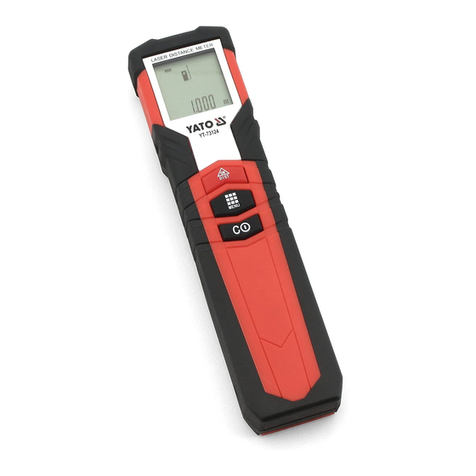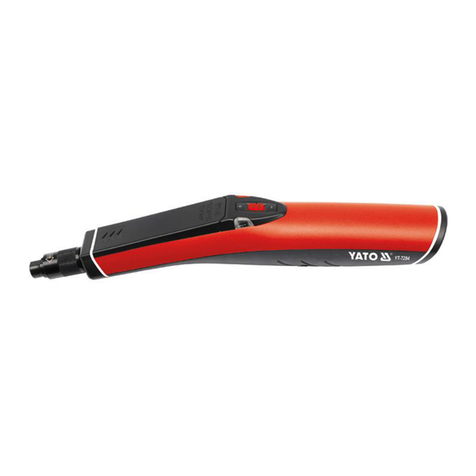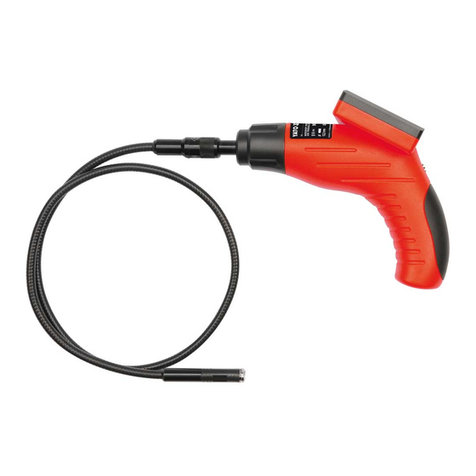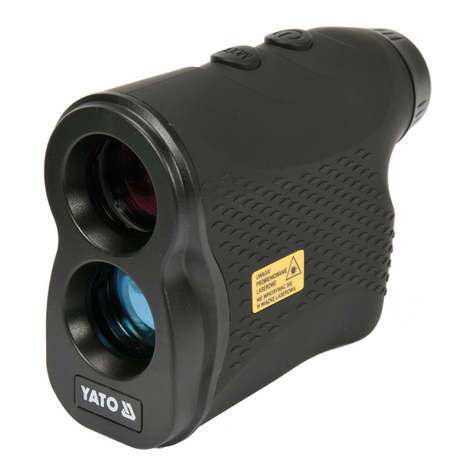
INSTRUKCJA ORYGINALNA
6
PL GB D RUS UA LT LV CZ SK H RO E F I NL GR
VIDES AIZSARDZĪBA
Simbols rāda izlietoto elektrisko un elektronisko iekārtu selektīvu savākšanu, Izlietotas elektriskas iekārtas ir otrreizējas izejvielas – nevar būt izme-
stas ar mājsaimniecības atkritumiem, jo satur substances, bīstamas cilvēku veselībai un videi! Lūdzam aktīvi palīdzēt saglabāt dabisku bagātību
un sargāt vīdi, pasniegšot izlietoto iekārtu izlietotas elektriskas ierīces savākšanas punktā. Lai ierobežot atkritumu daudzumu, tiem jābūt vēlreiz
izlietotiem, pārstrādātiem vai dabūtiem atpakaļcitāformā.
OCHRANA ŽIVOTNÍHO PROSTŘEDÍ
Symbol poukazuje na nutnost separovaného sběru opotřebovaných elektrických a elektronických zařízení. Opotřebovaná elektrická zařízení jsou
zdrojem druhotných surovin – je zakázáno vyhazovat je do nádob na komunální odpad, jelikož obsahují látky nebezpečné lidskému zdraví a
životnímu prostředí! Prosíme o aktivní pomoc při úsporném hospodaření s přírodními zdroji a ochraněživotního prostředí tím, že odevzdáte použité
zařízení do sběrného střediska použitých elektrických zařízení. Aby se omezilo množství odpadů, je nevyhnutné jejich opětovné využití, recyklace
nebo jiná forma regenerace.
OCHRANA ŽIVOTNÉHO PROSTREDIA
Symbol poukazuje na nutnosťseparovaného zberu opotrebovaných elektrických a elektronických zariadení. Opotrebované elektrické zariadenia sú
zdrojom druhotných surovín – je zakázané vyhadzovaťich do kontejnerov na komunálny odpad, nakoľko obsahujú látky nebezpečné ľudskému zdra-
viu a životnému prostrediu! Prosíme o aktívnu pomoc pri hospodárení s prírodnými zdrojmi a pri ochrane životného prostredia tým, že opotrebované
zariadenia odovzdáte do zberného strediska opotrebovaných elektrických zariadení. Aby sa obmedzilo množstvo odpadov, je nutné ich opätovné
využitie, recyklácia alebo iné formy regenerácie.
KÖRNYEZETVÉDELEM
A használt elektromos és elektronikus eszközök szelektív gyűjtésére vonatkozó jelzés: A használt elektromos berendezések újrafelhasználható ny-
ersanyagok – nem szabad őket a háztartási hulladékokkal kidobni, mivel az emberi egészségre és a környezetre veszélyes anyagokat tartalmaznak!
Kérjük, hogy aktívan segítse a természeti forrásokkal való aktív gazdálkodást az elhasznált berendezéseknek a tönkrement elektromos berende-
zéseket gyűjtőpontra történőbeszállításával. Ahhoz, hogy a megsemmisítendőhulladékok mennyiségének csökkentése érdekében szükséges a
berendezések ismételt vagy újra felhasználása, illetve azoknak más formában történővisszanyerése.
PROTEJAREA MEDIULUI
Simbolul adunării selective a utilajelor electrice şi electronice. Utilajele electrice uzate sunt materie primărepetată– este interzisăaruncarea lor la
gunoi, deoarece conţin substanţe dăunătoare sănătăţii omeneşti cât dăunătoare mediului! Vărugăm deci săaveţi o atitudine activăîn ceace priveşte
gospodărirea economicăa resurselor naturale şi protejarea mediului natural prin predarea utilajului uzat la punctul care se ocupăde asemenea
utilaje electrice uzate. Pentru a limita cantităţile deşeurilor eliminate este necesarăîntrebuinţatrea lor din nou , prin recyklind sau recuperarea în
altăformă.
PROTECCIÓN DEL MEDIO AMBIENTE
El símbolo que indica la recolección selectiva de los aparatos eléctricos y electrónicos usados. ¡Aparatos eléctricos y electrónicos usados son
reciclados – se prohíbe tirarlos en contenedores de desechos domésticos, ya que contienen sustancias peligrosas para la salud humana y para el
medio ambiente! Les pedimos su participación en la tarea de la protección y de los recursos naturales y del medio ambiente, llevando los aparatos
usados a los puntos de almacenamiento de aparatos eléctricos usados. Con el fin de reducir la cantidad de los desechos, es menester utilizarlos
de nuevo, reciclarlos o recuperarlos de otra manera.
ΗΠΡΟΣΤΑΣΙΑ ΤΟΥ ΠΕΡΙΒΑΛΛΟΝΤΟΣ
Το σύμβολο που υποδεικνύει την επιλεκτική συλλογή του αναλωμένου εξοπλισμού ηλεκτρικού και ηλεκτρονικού. Οαναλωμένος ηλεκτρικός εξο-
πλισμός είναι ανακυκλώσιμο υλικό – δεν πρέπει να πετάγεται στον κοινό κάδο σκουπιδιών, διότι περιέχει συστατικά επικίνδυνα για την ανθρώπινη
υγεία και το περιβάλλον! Παρακαλούμε να βοηθάτε δραστικά στην εξοικονομημένη διαχείριση των φυσικών πόρων και την προστασία του φυσικού
περιβάλλοντος μέσω της παράδοσης της αναλωμένης συσκευής στο σημείο διάθεσης των αναλωμένων ηλεκτρικών συσκευών. Για να περιορίσετε
την ποσότητα των αφαιρούμενων απόβλητων είναι απαραίτητη ηεκ νέου χρήση τους, ηανακύκλωση ήανακύκλωση σε άλλη μορφή.
PROTECTION DE L’ENVIRONNEMENT
Le symbole qui indique la collecte sélective des déchets d’équipements électriques et électroniques. Les dispositifs électriques usés sont des
matières recyclables – il est interdit de les jeter dans des récipients pour des ordures ménagères car ils contiennent des substances nocives pour
la santé humaine et l’environnement ! Nous vous prions de nous aider à soutenir activement la gestion rentable des ressources naturelles et à pro-
téger l’environnement naturel en rendant le dispositif usé au point de stockage des dispositifs électriques usés. Pour réduire la quantité de déchets
éliminés il est nécessaire de les réutiliser, de les recycler ou de les récupérer sous une autre forme.
BESCHERMING VAN HET MILIEU
Het symbool wijst op de selectieve inzameling van oude elektrische en elektronische apparatuur. Verbruikte elektrische apparaten kunnen worden
gerecycled. Het is verboden dit bij het huishoudelijk afval te gooien aangezien dit stoffen bevat die schadelijk kunnen zijn voor de gezondheid en voor
het milieu! Wij vragen u actief bij te dragen de economische natuurlijke hulpbronnen te besparen en het milieu te beschermen door deze gebruikte
apparaten in te leveren bij een speciaal punt dat hiervoor is bestemd. Om de verwijdering van afvalstoffen te verminderen is hergebruik, recycling of
het op een andere wijze herstellen noodzakelijk.
TUTELA DELL’AMBIENTE
Simbolo della raccolta selezionata dei prodotti elettrici ed elettronici fuori uso. I dispositivi elettrici fuori uso sono rifiuti riciclabili - non vanno buttati in
contenitori per rifiuti domestici, in quanto contengono sostanze pericolose per la salute e l’ambiente! Agite attivamente a favore della gestione eco-
nomica delle risorse naturali e a favore della protezione dell’ambiente, consegnando gli utensili fuori uso ai centri di raccolta. Per ridurre la quantità
dei rifiuti buttati, è necessario che siano riusati, riciclati o recuperati in qualsiasi modo.
































